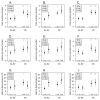Detection of pathogenic bacteria during rhinovirus infection is associated with increased respiratory symptoms and asthma exacerbations
- PMID: 24698319
- PMCID: PMC4047978
- DOI: 10.1016/j.jaci.2014.02.030
Detection of pathogenic bacteria during rhinovirus infection is associated with increased respiratory symptoms and asthma exacerbations
Abstract
Background: Detection of either viral or bacterial pathogens is associated with wheezing in children; however, the influence of both bacteria and viruses on illness symptoms has not been described.
Objective: We evaluated bacterial detection during the peak rhinovirus season in children with and without asthma to determine whether an association exists between bacterial infection and the severity of rhinovirus-induced illnesses.
Methods: Three hundred eight children (166 with asthma and 142 without asthma) aged 4 to 12 years provided 5 consecutive weekly nasal samples during September and scored cold and asthma symptoms daily. Viral diagnostics and quantitative PCR for Streptococcus pneumoniae, Haemophilus influenzae, and Moraxella catarrhalis were performed on all nasal samples.
Results: Detection rates were 53%, 17%, and 11% for H influenzae, S pneumoniae, and M catarrhalis, respectively, with detection of rhinovirus increasing the risk of detecting bacteria within the same sample (odds ratio [OR], 2.0; 95% CI, 1.4-2.7; P < .0001) or the following week (OR, 1.6; 95% CI, 1.1-2.4; P = .02). In the absence of rhinovirus, S pneumoniae was associated with increased cold symptoms (mean, 2.7 [95% CI, 2.0-3.5] vs 1.8 [95% CI, 1.5-2.2]; P = .006) and moderate asthma exacerbations (18% [95% CI, 12% to 27%] vs 9.2% [95% CI, 6.7% to 12%]; P = .006). In the presence of rhinovirus, S pneumoniae was associated with increased moderate asthma exacerbations (22% [95% CI, 16% to 29%] vs 15% [95% CI, 11% to 20%]; P = .01). Furthermore, M catarrhalis detected alongside rhinovirus increased the likelihood of experiencing cold symptoms, asthma symptoms, or both compared with isolated detection of rhinovirus (OR, 2.0 [95% CI, 1.0-4.1]; P = .04). Regardless of rhinovirus status, H influenzae was not associated with respiratory symptoms.
Conclusion: Rhinovirus infection enhances detection of specific bacterial pathogens in children with and without asthma. Furthermore, these findings suggest that M catarrhalis and S pneumoniae contribute to the severity of respiratory tract illnesses, including asthma exacerbations.
Keywords: Rhinovirus; asthma; bacteria.
Copyright © 2014 American Academy of Allergy, Asthma & Immunology. Published by Mosby, Inc. All rights reserved.
Figures


Similar articles
-
Association of rhinovirus and potentially pathogenic bacterial detections in the first 3 months of life with subsequent wheezing in childhood.Pediatr Pulmonol. 2023 Dec;58(12):3428-3436. doi: 10.1002/ppul.26667. Epub 2023 Sep 6. Pediatr Pulmonol. 2023. PMID: 37671813 Free PMC article.
-
Detection of viral, Chlamydia pneumoniae and Mycoplasma pneumoniae infections in exacerbations of asthma in children.J Clin Virol. 1999 Aug;13(3):131-9. doi: 10.1016/s1386-6532(99)00030-x. J Clin Virol. 1999. PMID: 10443789 Free PMC article.
-
Role of viruses and atypical bacteria in asthma exacerbations among children in Oporto (Portugal).Allergol Immunopathol (Madr). 2007 Jan-Feb;35(1):4-9. doi: 10.1157/13099088. Allergol Immunopathol (Madr). 2007. PMID: 17338895
-
Management of bacterial infections in children with asthma.Expert Rev Anti Infect Ther. 2009 Sep;7(7):869-77. doi: 10.1586/eri.09.58. Expert Rev Anti Infect Ther. 2009. PMID: 19735226 Review.
-
Rhinovirus Infections and Their Roles in Asthma: Etiology and Exacerbations.J Allergy Clin Immunol Pract. 2022 Mar;10(3):673-681. doi: 10.1016/j.jaip.2022.01.006. Epub 2022 Jan 22. J Allergy Clin Immunol Pract. 2022. PMID: 35074599 Free PMC article. Review.
Cited by
-
Temporal Dynamics of the Nasopharyngeal Microbiome and its Relationship with Childhood Asthma Exacerbation.Microbiol Spectr. 2022 Jun 29;10(3):e0012922. doi: 10.1128/spectrum.00129-22. Epub 2022 May 12. Microbiol Spectr. 2022. PMID: 35546575 Free PMC article.
-
Dysbiotic lung microbial communities of neonates from allergic mothers confer neonate responsiveness to suboptimal allergen.Front Allergy. 2023 Mar 10;4:1135412. doi: 10.3389/falgy.2023.1135412. eCollection 2023. Front Allergy. 2023. PMID: 36970065 Free PMC article.
-
Interactions of Bacteriophages and Bacteria at the Airway Mucosa: New Insights Into the Pathophysiology of Asthma.Front Allergy. 2021 Jan 26;1:617240. doi: 10.3389/falgy.2020.617240. eCollection 2020. Front Allergy. 2021. PMID: 35386933 Free PMC article. Review.
-
Rhinovirus Attributes that Contribute to Asthma Development.Immunol Allergy Clin North Am. 2019 Aug;39(3):345-359. doi: 10.1016/j.iac.2019.03.004. Epub 2019 May 7. Immunol Allergy Clin North Am. 2019. PMID: 31284925 Free PMC article. Review.
-
Childhood asthma heterogeneity at the era of precision medicine: Modulating the immune response or the microbiota for the management of asthma attack.Biochem Pharmacol. 2020 Sep;179:114046. doi: 10.1016/j.bcp.2020.114046. Epub 2020 May 22. Biochem Pharmacol. 2020. PMID: 32446884 Free PMC article. Review.
References
-
- Bisgaard H, Hermansen MN, Buchvald F, Loland L, Halkjaer LB, Bonnelykke K, et al. Childhood asthma after bacterial colonization of the airway in neonates. The New England journal of medicine. 2007;357(15):1487–95. Epub 2007/10/12. - PubMed
Publication types
MeSH terms
Substances
Grants and funding
LinkOut - more resources
Full Text Sources
Other Literature Sources
Medical

